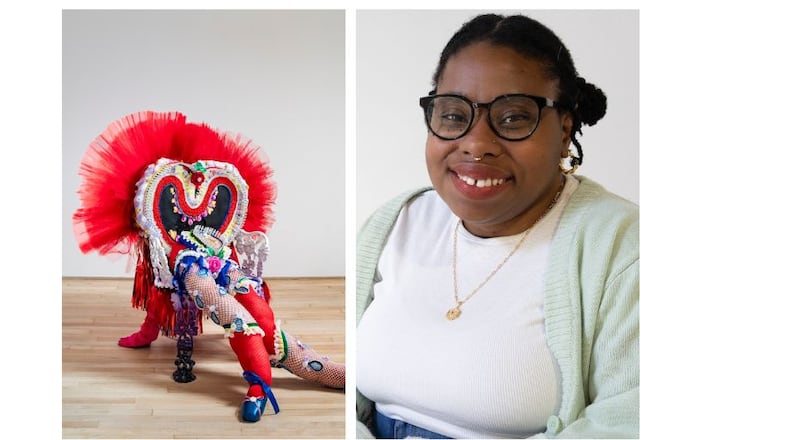Artist Victoria Dugger has the sweet, high-pitched voice of a Disney princess. But don’t let the sugar fool you.
“There’s a ton of inner rage. I feel very punk rock,” she said.
It’s one of the many dichotomies that define Dugger’s life and work. The Athens-based artist lards her mixed media paintings with all manner of girliness: roses and glitter, fringe and gingham, hair bows and pink hearts. She then layers on “The Substance”-level body horror: rotten teeth in gummy smiles, lurking monsters with salivating mouths and innards twisted into knots.
Dugger’s puree of cutie pie and the grotesque has garnered the artist armfuls of accolades and attention, including two solo exhibitions at the New York City gallery Sargent’s Daughters, glowing write-ups in Vogue and The New York Times and now a $50,000 pay day as the 2024 recipient of the local Hudgens Prize, one of the largest awards given to an American artist. The prize also comes with a solo exhibition in 2025 at the Hudgens Center for Art & Learning in Duluth.
The seventh winner of the biennial prize, Dugger, 33, plans to use the money to hire a studio assistant and buy equipment that will help her work on a larger scale. She might get a scissor lift or something like another disabled painter used. “I know Chuck Close had some kind of mechanism, like a platform, and the painting would actually kind of roll up or down according to where he was on the platform.”
Credit: NICHOLAS KNIGHT
Credit: NICHOLAS KNIGHT
Art-making is all about problem solving and thinking outside the box, and for someone confined to a wheelchair with limited mobility, thinking differently has always been part of Dugger’s secret sauce.
The artist’s deliciously bizarro blends of art history, underground comics and the distorted bodies of Peter Saul or British artist Sarah Lucas have proven a hit with curators like Atlanta-based Melissa Messina.
“Her sculptures are somehow intimately familiar and yet other-worldly, deeply serious yet comical. In each she is really pushing boundaries,” said Messina.
Dugger’s stuffed sculptures of humanoid forms are flaccid lumps with limbs akimbo. But their color scheme of neon pinks and purples paired with satin ballet shoes, ribbons and bows make them also kind of huggable. The works are simultaneously cute and rude, like a schoolgirl flipping her teacher the bird. As Charli XCX says, “It’s so confusing sometimes to be a girl.”
Dugger’s sculpture “Sugar Coat It” (2024) references heart-shaped Valentine’s Day candy boxes and ballerinas en pointe, but it delivers all that yumminess with a dark, vicious sense of humor. The woman’s body in that soft sculpture has a white picket fence like a no-go zone around her privates and pink roses at the crotch. On her head she wears a crimson ballerina tutu like a lion’s mane.
Dugger’s work peels back the veneer of girlhood and channels her own experiences coming of age, including enduring the “psychological warfare” of girls, with all the meanness and complexity that implies, combined with Dugger’s unique circumstance as a disabled woman navigating rites of passage.
“Her brand of feminism is fresh to me, and I want to champion the ways in which she is unabashedly exploring representations of girlhood, womanhood, and the body,” said Messina, one of three curators who selected Dugger for the Hudgens Prize. “It is refreshing to see it being celebrated by an art world that hasn’t historically been open to it.”
Messina — along with curator Sierra King — also chose Dugger for a 2023 Atlanta Contemporary exhibition, “New Worlds: Georgia Women to Watch,” presented by the Georgia Committee of the National Museum of Women in the Arts.
In 1995 at age 3, Dugger underwent cervical scoliosis surgery on her neck at the New Orleans Children’s Hospital. “I died on the operating table but was resuscitated,” said Dugger.
The corrective surgery left her paralyzed and Dugger spent nine months in the hospital, part of that time in a coma. “It was like a mini bomb kind of blew up in my family. It was just highly, highly traumatic to my mom and my dad and my brothers, even my aunts and cousins.” Her extended family pulled together and moved to Louisiana to support her parents.
Credit: NICHOLAS KNIGHT
Credit: NICHOLAS KNIGHT
Dugger had to relearn everything and adjust to the wheelchair, but she doesn’t remember life before the surgery. “Disabled people that become disabled, you know, later in life, I haven’t had that experience,” she said. “I’ve always been this way and, like, nothing is wrong with me.”
Dugger described her childhood growing up with older twin brothers on a cul de sac in Columbus as “very idyllic.” But the distinct awareness of her body as a contested place, of a place that was invaded and altered, invests Dugger’s artwork with a sense of detachment that gives her paintings and sculptures their strange, uncanny appeal. In her artworks, one figure often confronts another, like two sides of Dugger’s own self.
“I definitely feel almost separated from my body in a sense,” she said. “I’ve always kind of had this close relationship with the grotesque and the body not being in its, you know, most perfect state. I think I’m not afraid of that at all.”
In “The Devil Makes Three” (2022), a girl in pigtails and blue hair bows recoils in fear at a figure with wild eyes and dagger-like claws reflected in her bedroom mirror. It’s a riff on classic paintings of female vanity or of Narcissus hypnotized by his reflection, layered with an added blast of disassociation.
Her scenes also feel uniquely gendered, both reveling in the tropes of femininity while also taking them to outlandish extremes with maximalist levels of glitter and bows and gingham. Dugger is thinking about going even deeper into that weird inside-outside dichotomy in her future work.
Dugger was an imaginative kid with a rich inner life and a love of books and Disney movies. Art school gave her the chance to connect with her professors and fellow students in a deeper way. While studying painting and drawing at Columbus State University and earning a master’s degree in studio and design at the University of Georgia, she began to use her art to delve into her identity issues.
“When I was a kid, not being able to play on the playground that much affected me,” said Dugger. Art school proved to be the antidote. “I felt that my professors and my classmates were really able to validate things that I was thinking about.”
Dugger learned early on that she would encounter limitations and recognizing that prepared her for some of the hard knocks of adulthood. Layer on being a woman and Black, and you have a potent brew for artistic exploration of self and society.
“I definitely have always felt very invisible at times, and overly hyper visible at the same time,” noted Dugger.
Growing up, it wasn’t always Ariel, Jasmine or Belle that she felt a kinship with. She could imagine another vantage. “I saw myself in a lot of those films like the ‘The Hunchback of Notre Dame.’ And ‘Beauty and the Beast’ is a film I think about all the time,” she said.
“People see me as one way. I sound very young, my voice is very innocent as well. So, I surprise a lot of people when they actually do talk to me.”
About the Author
Keep Reading
The Latest
Featured



